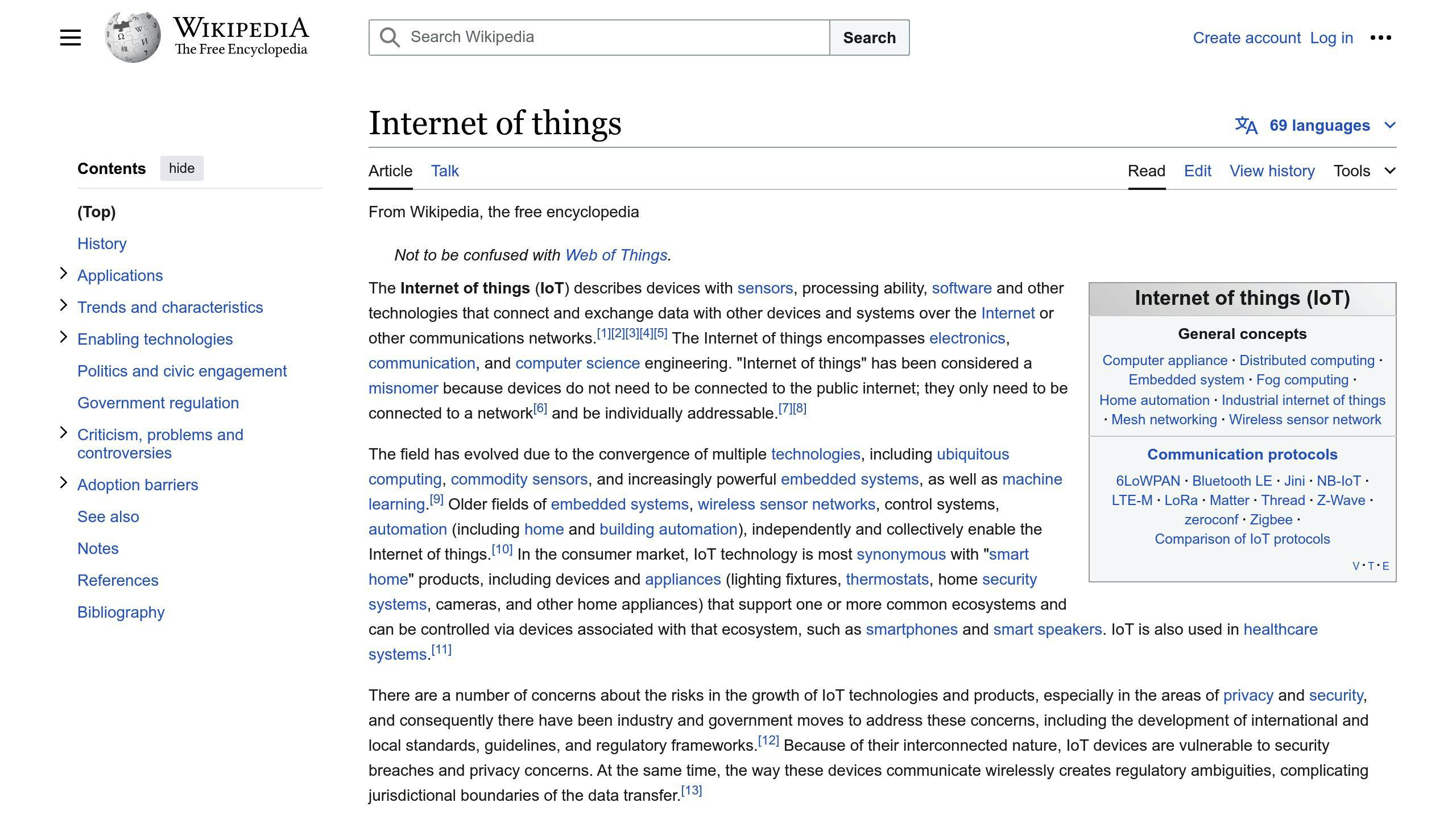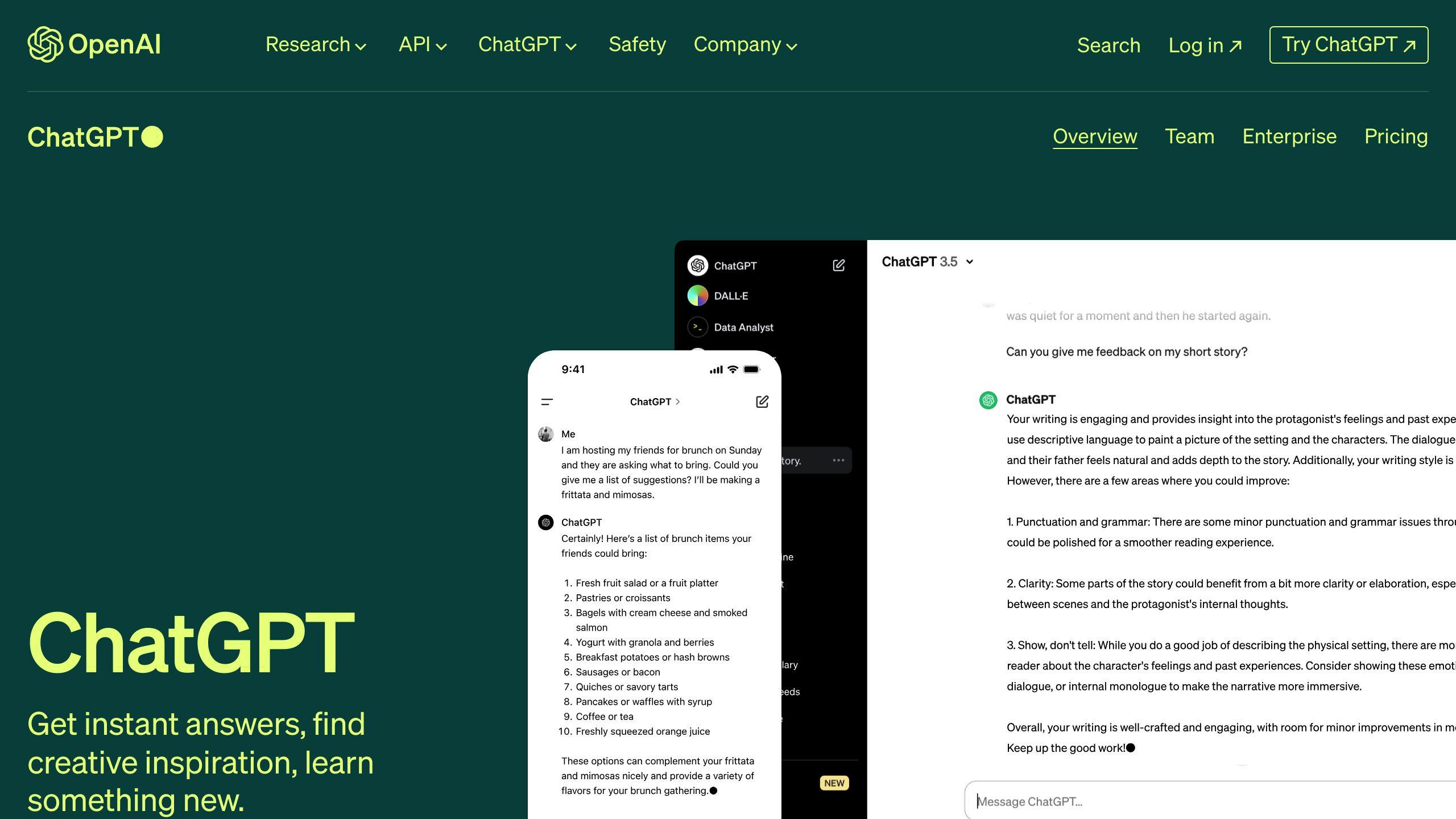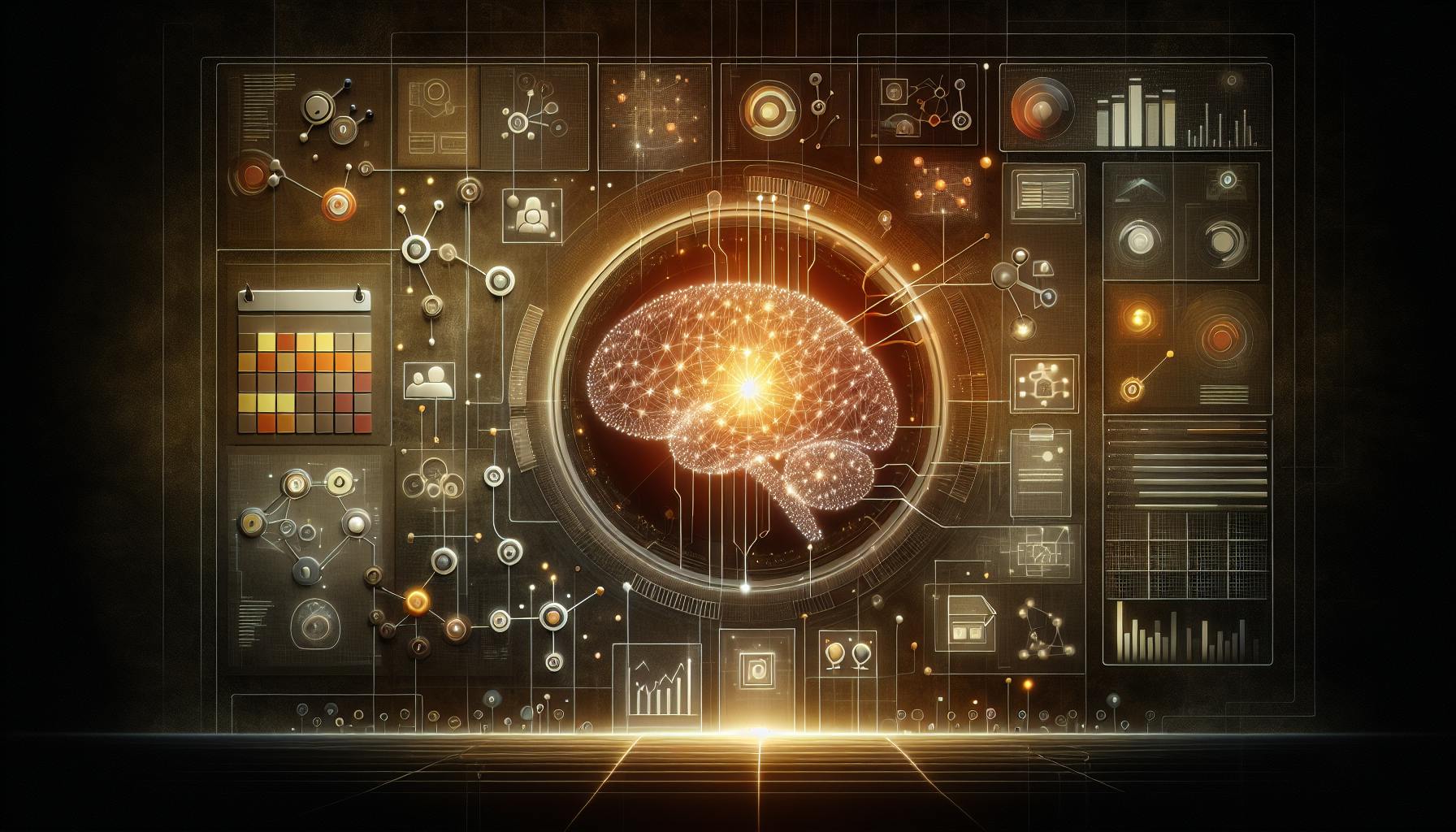Integrating ChatGPT with Internet of Things (IoT) devices enables natural language interactions, revolutionizing how we control and manage smart devices. With ChatGPT, users can communicate with devices using everyday language, eliminating complex commands or programming.
Key Benefits:
- Simplified Interactions: Communicate with IoT devices using natural language
- Increased Accessibility: IoT devices become user-friendly for all ages and technical abilities
- Improved Efficiency: Control and monitor devices with ease for a more convenient life
ChatGPT-IoT integration enables proactive device responses, goal-oriented control, personalized experiences, and remote management capabilities across various industries, including:
| Industry | Use Case |
|---|---|
| Smart Homes | Voice control over lighting, temperature, security systems |
| Industrial | Monitor and optimize machinery, processes through intuitive commands |
| Healthcare | Interpret real-time patient data, provide personalized treatment suggestions |
As the technology evolves, we can expect a world of seamless communication, interconnected devices, and improved efficiency and sustainability through optimized energy consumption, healthcare outcomes, and industrial productivity.
Related video from YouTube
What is the Internet of Things?

The Internet of Things (IoT) is a network of devices, vehicles, appliances, and other items that are embedded with sensors, software, and connectivity. This allows them to collect and exchange data with other devices and systems over the internet.
Types of IoT Devices
IoT devices can range from simple household appliances to complex industrial machinery and transportation systems. Some examples include:
- Smart home devices (e.g., thermostats, lighting systems)
- Wearable devices (e.g., fitness trackers, smartwatches)
- Industrial equipment (e.g., manufacturing machines, sensors)
- Transportation systems (e.g., smart traffic management, autonomous vehicles)
How IoT Works
IoT devices communicate with each other and with other internet-enabled devices, creating a vast network of interconnected devices. This enables them to:
- Collect and exchange data
- Perform tasks autonomously
- Improve efficiency and functionality in various industries
Benefits of IoT
The significance of IoT lies in its ability to:
- Enhance efficiency and functionality in various industries
- Improve decision-making
- Reduce costs
- Increase productivity
For example, in healthcare, IoT devices can monitor patients' vital signs remotely, enabling healthcare professionals to provide more timely and effective care. In home automation, IoT devices can optimize energy consumption and improve home security.
As IoT continues to evolve, we can expect to see even more innovative applications and benefits across various industries.
Understanding ChatGPT

ChatGPT is a powerful language model developed by OpenAI. It can generate human-like text in response to various prompts. This AI tool is useful for tasks like language translation, text summarization, and conversation generation. It can assist in areas such as customer service, content creation, language learning, research, and more.
How ChatGPT Works
ChatGPT's natural language processing capabilities make it an ideal tool for making interactions with IoT devices more intuitive and user-friendly. By integrating ChatGPT with IoT devices, users can communicate with devices using everyday language, eliminating the need for complex commands or programming.
Benefits of ChatGPT in IoT
| Benefits | Description |
|---|---|
| Simplified Interactions | Users can communicate with devices using natural language |
| Increased Accessibility | IoT devices become more user-friendly and accessible to people of all ages and technical abilities |
| Improved Efficiency | Devices can be controlled and monitored with ease, making our lives more convenient |
As a result, ChatGPT has the potential to revolutionize the way we interact with devices, making it easier for people to control and manage their smart homes, industrial equipment, and other IoT-enabled devices.
From Commands to Conversations
The way we interact with devices has changed significantly over the years. From static interfaces to dynamic conversational engagements, the evolution of device interaction methods has been remarkable. Traditionally, users had to navigate through complex menus, remember specific commands, and understand proprietary languages to control their devices. This complexity often led to user inconvenience, frustration, and a steep learning curve.
Simplifying Interactions with ChatGPT
With the advent of conversational AI, such as ChatGPT, the landscape of device interactions is changing rapidly. ChatGPT enables natural language interactions, making it easier for people to control and manage their devices. By leveraging the power of conversational AI, users can now communicate with devices using everyday language, eliminating the need for complex commands or programming.
Benefits of Conversational AI
| Benefits | Description |
|---|---|
| Simplified Interactions | Users can communicate with devices using natural language |
| Increased Accessibility | IoT devices become more user-friendly and accessible to people of all ages and technical abilities |
| Improved Efficiency | Devices can be controlled and monitored with ease, making our lives more convenient |
The shift from commands to conversations has far-reaching implications for the IoT ecosystem. It enables users to interact with devices in a more intuitive and user-friendly manner, increasing accessibility and adoption. Moreover, conversational AI can help devices to better understand user intent, provide personalized experiences, and offer proactive responses, ultimately leading to a more efficient and convenient interaction experience.
As we move forward, the integration of ChatGPT with IoT devices is expected to revolutionize the way we live and work. By harnessing the power of conversational AI, we can create a more connected, efficient, and user-centric world, where devices are no longer a barrier, but a facilitator of human progress.
Integrating ChatGPT with IoT Devices
Integrating ChatGPT with IoT devices is a crucial step in creating a seamless and intuitive interaction experience. This section will provide a comprehensive guide on how to integrate ChatGPT with IoT devices, including considerations for choosing platforms, setting up communication protocols, and developing conversational interfaces.
Choosing Integration Platforms
When selecting a platform for integrating ChatGPT with IoT devices, consider the following factors:
| Factor | Description |
|---|---|
| Scalability | Handle a large number of devices and conversations simultaneously |
| Security | Ensure secure data transmission and storage |
| Compatibility | Compatible with various IoT devices and protocols |
| Ease of use | User-friendly interface for developers |
Some popular platforms for integrating ChatGPT with IoT devices include cloud services like AWS IoT, Google Cloud IoT Core, and Microsoft Azure IoT Hub, as well as on-premises solutions like Eclipse Mosquitto and HiveMQ.
Communication Protocols for IoT
Communication protocols play a vital role in enabling ChatGPT and IoT devices to interact efficiently. Some popular communication protocols for IoT devices include:
| Protocol | Description |
|---|---|
| MQTT (Message Queuing Telemetry Transport) | Lightweight protocol for low-bandwidth, high-latency networks |
| CoAP (Constrained Application Protocol) | Protocol designed for constrained networks and devices |
| HTTP (Hypertext Transfer Protocol) | Widely used protocol for web-based applications |
When choosing a communication protocol, consider factors like device capabilities, network constraints, and security requirements.
Creating Conversational Interfaces
Creating user-friendly conversational interfaces with ChatGPT is crucial for a seamless interaction experience. Here are some tips for developing conversational interfaces:
| Tip | Description |
|---|---|
| Natural Language Understanding (NLU) | Enable ChatGPT to understand user intent and respond accordingly |
| Contextual Awareness | Design the interface to maintain context throughout the conversation |
| Error Handling | Implement error handling mechanisms to handle unexpected user inputs or errors |
By following these guidelines, you can create a conversational interface that provides a natural and intuitive interaction experience for users.
Remember to prioritize scalability, security, and ease of use when integrating ChatGPT with IoT devices. By choosing the right platform, communication protocol, and conversational interface, you can create a seamless and efficient interaction experience for users.
sbb-itb-b2c5cf4
Benefits of ChatGPT and IoT Integration
Discover the advantages of combining ChatGPT with IoT devices, including improved responsiveness, goal-oriented control, personalized experiences, and remote management capabilities.
Proactive Device Responses
ChatGPT enables devices to respond proactively to user needs, potentially preventing issues before they occur. For example, a smart home system integrated with ChatGPT can detect unusual energy consumption patterns and alert homeowners to take corrective action.
Goal-Based Device Control
Explore the shift towards goal-oriented device interactions, where users set objectives and rely on ChatGPT to execute the necessary commands. This approach simplifies device management, as users focus on achieving specific goals rather than issuing individual commands.
| Goal | Example |
|---|---|
| Make my home cozy | Adjust lighting, temperature, and entertainment settings |
| Prepare my home for bedtime | Lock doors, turn off lights, and adjust thermostat |
Personalized User Experiences
ChatGPT learns from interactions and adapts to user preferences, delivering increasingly personalized experiences over time. By analyzing user behavior and device interactions, ChatGPT provides tailored recommendations, automates routine tasks, and enhances overall user satisfaction.
Remote Device Management
Consider the importance of mobility in device interactions and how ChatGPT extends remote management capabilities through cloud-based solutions. This enables users to control and monitor devices from anywhere, at any time, using their preferred device.
By integrating ChatGPT with IoT devices, users can unlock a range of benefits, from improved device responsiveness to personalized experiences and remote management capabilities. As the IoT landscape continues to evolve, the possibilities for ChatGPT-powered device interactions will only continue to grow.
Challenges in ChatGPT-IoT Integration
Integrating ChatGPT with IoT devices can be a complex process, and several challenges must be addressed to ensure successful deployment.
Data Privacy and Security
Protecting user data is crucial when integrating ChatGPT with IoT devices. This includes:
| Challenge | Description |
|---|---|
| Data Encryption | Encrypting data to prevent unauthorized access |
| Secure API Practices | Implementing secure API practices to prevent cyber attacks |
| Access Controls | Implementing robust access controls, such as multi-factor authentication and secure authorization mechanisms |
Device Compatibility and Standards
Ensuring device compatibility and establishing industry-wide standards is essential for seamless integration with ChatGPT. This includes:
| Challenge | Description |
|---|---|
| Standardized APIs | Developing standardized APIs to facilitate communication between devices and platforms |
| Device Compatibility | Ensuring device manufacturers make their devices compatible with ChatGPT |
| Communication Protocols | Establishing standardized communication protocols for IoT devices |
Technical Limitations
ChatGPT requires significant computational resources to function effectively, which can be a challenge for IoT devices. This includes:
| Challenge | Description |
|---|---|
| Processing Power | IoT devices may not possess the necessary processing power to support ChatGPT |
| AI Training | Continual AI training is required to maintain the effectiveness of ChatGPT-integrated systems, which can be resource-intensive |
By addressing these challenges, we can ensure successful integration of ChatGPT with IoT devices and unlock the full potential of this technology.
Real-World ChatGPT and IoT Applications
ChatGPT's integration with IoT devices is transforming various industries and aspects of our lives. From smart homes to industrial settings, the possibilities are endless. Let's explore some real-world applications and case studies where ChatGPT is making a significant impact.
Smart Home Automation
Imagine controlling your home's temperature, lighting, and security systems with just your voice. ChatGPT enables residents to manage their living spaces more efficiently, creating a seamless and comfortable experience.
| Command | Action |
|---|---|
| "Turn off the lights in the living room" | Adjust lighting settings |
| "Adjust the thermostat to 72°F" | Control temperature |
Industrial Efficiency
In industrial settings, ChatGPT is empowering operators to monitor, control, and optimize machinery and processes through intuitive commands and feedback.
| Command | Action |
|---|---|
| "Show me the current production rate" | Display production data |
| "Alert me when the machine needs maintenance" | Receive maintenance notifications |
Healthcare Device Integration
ChatGPT is also transforming the healthcare industry by assisting medical staff in providing better care to patients. IoT healthcare devices, combined with ChatGPT, can provide real-time data interpretation and patient interaction.
| Command | Action |
|---|---|
| "Display the patient's vital signs" | View patient data |
| "Recommend the best course of treatment" | Receive personalized treatment suggestions |
These real-world applications demonstrate the potential of ChatGPT and IoT integration to transform various industries and aspects of our lives. As the technology continues to evolve, we can expect to see even more innovative and practical applications in the future.
The Future of Connected Devices
The integration of ChatGPT and IoT devices is set to revolutionize the way we interact with technology, changing the landscape of connected devices. As we move forward, we can expect to see more innovative applications of this technology, improving our daily lives and industries.
A World of Seamless Communication
Imagine a world where you can effortlessly control your smart home, receive personalized healthcare recommendations, or optimize industrial processes with just your voice. This is the potential of ChatGPT-IoT integration.
Interconnected Devices
As the technology evolves, we can expect to see more devices become interconnected, creating a vast network of IoT devices that can learn from each other and improve our lives. ChatGPT's natural language processing capabilities will play a crucial role in facilitating this communication, enabling devices to understand and respond to human language in a more intuitive way.
A More Efficient and Sustainable World
The future of connected devices is not just about convenience; it's about creating a more efficient, sustainable, and connected world. With ChatGPT-IoT integration, we can expect to see significant improvements in areas such as energy consumption, healthcare outcomes, and industrial productivity.
Key Benefits
| Area | Improvement |
|---|---|
| Energy Consumption | Reduced energy waste and optimized usage |
| Healthcare Outcomes | Personalized recommendations and improved patient care |
| Industrial Productivity | Optimized processes and increased efficiency |
By harnessing the power of ChatGPT-IoT integration, we can create a better future for all.
Resources on ChatGPT and IoT
For further exploration of ChatGPT and IoT, here are some curated resources:
Technical Specifications
| Resource | Description |
|---|---|
| OpenAI's ChatGPT API documentation | A comprehensive guide to integrating ChatGPT with IoT devices |
| IoT device manufacturers' documentation | Check the documentation of your IoT device manufacturer for specific integration guides and technical specifications |
Integration Guides
| Platform | Description |
|---|---|
| AWS IoT Core | ChatGPT-IoT integration tutorials on AWS |
| Google Cloud IoT Core | ChatGPT-IoT integration tutorials on Google Cloud |
| Microsoft Azure IoT Hub | ChatGPT-IoT integration tutorials on Microsoft Azure |
| Home Assistant | IoT device integration guides on Home Assistant |
| OpenHAB | IoT device integration guides on OpenHAB |
| IoTIFY | IoT device integration guides on IoTIFY |
Platforms Supporting ChatGPT-IoT Integration
| Platform | Description |
|---|---|
| AWS IoT Core | A cloud-based platform for IoT device management and integration with ChatGPT |
| Google Cloud IoT Core | A fully managed service for IoT device management and integration with ChatGPT |
| Microsoft Azure IoT Hub | A cloud-based platform for IoT device management and integration with ChatGPT |
These resources will provide you with a solid foundation for exploring the possibilities of ChatGPT-IoT integration and building innovative applications.

